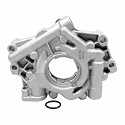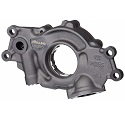
Function Of An Oil Pump
As the name suggests, an oil pump’s function is to pump the engine oil around the engine to ensure that adequate lubrication is established and maintained between all wear surfaces such as crankshaft bearings, camshaft bushings, and timing components under all operating conditions.
On engines that are fitted with variable valve or camshaft timing systems, the oil pump also supplies pressurized oil to the mechanisms and actuators that actively alter the valve or camshaft timing to achieve better performance.
Although design specifics vary greatly between manufacturers, all automotive oil pumps work on a variable geometry principle, in the sense that each rotation of the pump creates internal volumes that change as the pump rotates, which means that all oil pumps are positive displacement devices.
As a practical matter, oil that enters the pump through a port on the suction side is literally displaced toward a volume that gets progressively smaller as the pump rotates. Provided that all the clearances in the engine are within specification, the viscosity of the oil ensures that the decreasing volume of the discharge (delivery) side increases the pressure within the pump, until the pressurized oil is discharged into the oil circulation system at the point where the discharge chamber’s volume is at its smallest.
It should be noted though that the suction and discharge chambers within the oil pump are separated from each other by a rotor (or sometimes, by two meshing gears), but that sufficient clearance between the rotor (or gears), and the casing ensures that all moving parts of the pump receive adequate lubrication. Put in another way, this means that oil pumps that are in good condition allow a minute quantity of oil to leak past all internal sealing surfaces in order to prevent direct metal-to-metal contact between moving parts. This keeps the pump properly lubricated.
Common Symptoms Of A Faulty Oil Pump
Oil pumps very rarely (if ever) fail outright. The most common problem with oil pumps involves excessive mechanical wear caused by dirty, contaminated, or degraded oil that eventually creates such large internal clearances in the pump that adequate oil pressure cannot be maintained. Thus, the most common symptoms of a failed of failing oil pump could include the following:
Illuminated Oil Pressure Warning Light
All engines are equipped with oil pressure sensors whose sole function it is to monitor the oil pressure at various points in the oil circulation system. Thus, when one or more oil pressure sensors detects an abnormally low oil pressure condition, one or more warning lights may be illuminated on the dashboard, and in some cases, audible alarms may also be activated. These warnings should NOT be ignored.
Mechanical Noise
Typical noises could include knocking, thumping, or ticking sounds that typically vary with engine speed. Note that once these sounds occur, the engine may already be severely damaged.
Loss of Power
Since variable valve and camshaft timing systems require pressurized oil to work, a lack of oil pressure could disable these systems if equipped on your vehicle, or cause either over or under adjustment of the valve or camshaft timing, which can have a severe negative effect on engine operation and power delivery.
Replacing An Oil Pump
It should be noted that replacing an oil pump almost always involves substantial disassembly of major components, depending on where the oil pump is located. If the oil pump is driven directly by the crankshaft, it may be necessary to remove the auxiliary drive belts, as well as the timing cover, since in many cases the oil pump is incorporated into the timing cover. Note though that in some cases, it may be necessary to remove the timing chain(s) and related sprockets and associated tensioning devices as well. If the oil pump is located in the oil pan, it may be necessary to remove major suspension and subframe components just to be able to remove the oil pan to gain access to the oil pump.
Note: The example steps below are intended for general informational purposes solely to help give you an idea of project difficulty and tools required. As all cars are engineered differently, repair procedures and safety hazards vary from vehicle to vehicle. To ensure that you have a vehicle specific repair procedure and an exhaustive list of potential safety hazards, we advise you reference a factory service manual for your vehicle. Similarly, referencing a repair manual such as Chilton or Haynes might serve as a less expensive alternative.
Step 1 – The first and most important step involves consulting the factory service manual to locate the oil pump, and to determine if you have the time, skills, and equipment that you need to perform the replacement. If you have ANY doubts about your ability to do this, the better option by far would be to seek professional assistance.
Step 2 – If you have located the oil pump and are up to the challenge, place the vehicle on a solid, level surface, lift it off the ground using an appropriately rated floor jack, and support it with jack stands. Observe all safety precautions, and make sure the vehicle cannot slip off the stands. You will also need to drain the car’s oil which will require an oil catch pan.
Step 3 – If the oil pump is incorporated into the timing cover, refer to the manual for details on how to remove all parts and components that prevent clear and easy access to the timing cover. Note that you may also need to remove auxiliary drive belts, the radiator, cooling fans, the A/C condenser and or hoses, as well as the harmonic balancer and other parts like the water pump. You will at minimum require a socket set to complete this step. You may also need a fan clutch wrench and a set of open wrenches. If you need to pull the harmonic balancer, a gear puller or similar and a breaker bar will be required to remove the component.
Step 4 – Follow the directions provided in the manual exactly when removing the timing cover, and note the lengths of the retaining bolts. If necessary, draw a diagram of the positions of all bolts in order to prevent forcing the wrong length bolt into the wrong hole upon reassembly. It’s possible that some of these bolts will be difficult to access, so a set of deep sockets or a set of socket extensions will likely make this job easier.
Step 5 – If the oil pump is not located behind or in the timing cover, you will need to remove the oil pan, which in turn, could require removal or substantial disassembly of suspension components, or removal of engine and/or transmission mounts. This procedure can be quite extensive if you have to drop the subframe of the vehicle. Make proper notes of which bolt, nut or other fastener goes where, and if necessary, draw a diagram of the positions of all bolts in order to prevent forcing the wrong length bolt into the wrong hole upon reassembly.
Step 6 – Once the oil pan and/or timing cover is out of the way, remove the old oil pump, and install the replacement. Pay close attention to the placement of oil seals, gaskets, and/or O-rings to prevent a loss of oil pressure. Tighten all retaining bolts to their specified torque values using a torque wrench with an appropriate torque range to prevent the oil pump from coming loose due to vibration or leaking during operation.
Note that the new oil pump may require pre-lubrication or priming, which may be indicated in the service manual or by the pump manufacturer. Follow the directions exactly in order to ensure that the new oil pump works as expected. Failure to prime the new pump could lead to engine failure!
Step 7 – Reassemble all parts in the reverse order of removal, but if the timing chains were removed, pay close attention to the engine timing procedure described in the manual. Be aware that getting the valve timing wrong can cause extensive damage to valves, pistons, camshafts, and other components. Use new gaskets when installing the timing cover and oil pan, insert the correct bolts into the correct holes, and use a torque wrench with an appropriate torque range to tighten all bolts to their specified torque values.
Step 8 – Lower the vehicle to the ground, replace the oil filter, and fill the engine with the recommended oil before starting the engine.
If you are sure the engine oil is up to the mark on the dipstick, start the engine and verify that the oil pressure warning light extinguishes at idle speed after a few seconds. If it doesn’t, turn the engine off, troubleshoot, and repeat steps as necessary.
Best Oil Pump Brands
DNJ
 DNJ only supplies oil pumps from manufacturers that hold valid ISO9001, ISO9002, and the prestigious QS9000 certificate, which ensures that the pump you purchase meets or exceeds all OEM specifications. With more than 30 years of experience in the industry, DNJ can supply oil pumps and other engine parts for almost any vehicle on the market. These pumps are typically high quality and have been used successfully in many automotive applications. We think you are on steady footing if you choose to replace your oil pump with a DNJ.
DNJ only supplies oil pumps from manufacturers that hold valid ISO9001, ISO9002, and the prestigious QS9000 certificate, which ensures that the pump you purchase meets or exceeds all OEM specifications. With more than 30 years of experience in the industry, DNJ can supply oil pumps and other engine parts for almost any vehicle on the market. These pumps are typically high quality and have been used successfully in many automotive applications. We think you are on steady footing if you choose to replace your oil pump with a DNJ.
Click here to find a DNJ oil pump for your vehicle.
Melling
 Melling has been manufacturing oil pumps and other engine parts for more than sixty years, and all their products, including oil pumps, are individually tested to ensure that each pump provides dependable performance, reliability and ease of fitment that meets or exceeds OEM standards and specifications. Melling manufactures and supplies oil pumps for all applications, including competition and racing applications, so you can be confident that your engine will be always be fully protected against low oil pressure issues. Accordingly, we don’t hesitate to give Melling a strong recommendation.
Melling has been manufacturing oil pumps and other engine parts for more than sixty years, and all their products, including oil pumps, are individually tested to ensure that each pump provides dependable performance, reliability and ease of fitment that meets or exceeds OEM standards and specifications. Melling manufactures and supplies oil pumps for all applications, including competition and racing applications, so you can be confident that your engine will be always be fully protected against low oil pressure issues. Accordingly, we don’t hesitate to give Melling a strong recommendation.
